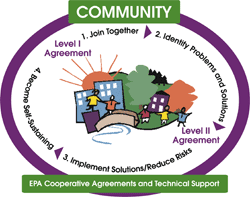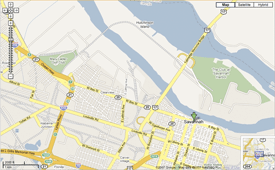Community Action for a Renewed Environment (CARE)
Savannah’s Community Environmental Collaborative
Fall 2007

About CARE
Community Action for a Renewed Environment (CARE) is an EPA technical assistance and grant program that offers an innovative way for a community to organize and take action to reduce toxic pollution in the local environment.
Level I, Level II Grants
Awarded at two monetary levels, over two years, CARE grants help communities tackle their problems using a four-step process (diagram below). Level I grants (up to $100,000) enable communities to progress through the first two steps, which are: 1) build a broad-based partnership, and 2) identify a range of environmental problems and solutions. Level II grants (up to $300,000) fund the next two steps, which are: 3) take action to reduce risks; and 4) become self-sustaining.
The neighborhoods of Hudson Hill and Woodville in Savannah, Georgia, are home to 1600 people, 97 percent of whom are people of color and the 75.5 percent of whom live below the federal poverty level. The small, 4.4 square-mile neighborhoods are surrounded by 17 industries, and residents are primarily concerned about health risks from air toxics sources. In 2004, the nonprofit organization Harambee House in Savannah received an Environmental Justice Collaborative Problem-Solving (EJ CPS) grant from EPA. Working with Hudson Hill and other partners, Harambee House documented community history and health concerns. Building on the model developed with Hudson Hill, Harambee House developed the Savannah Community Environmental Collaborative to expand its work to Woodville. The purpose of the CARE Level I project is to engage the residents from both neighborhoods in the risk assessment process and prioritize actions that restore community confidence in their ability to reduce harm to their health and neighborhoods.

Step 1: Joining Together
The CARE partnership builds on relationships formed during the EJ CPS project in Hudson Hill. The Georgia Environmental Protection Division, Chatham County Health Department, Savannah Development and Renewal Authority, Eastside Concerned Citizens and the U.S. Agency for Toxic Substances and Disease Registry are core partners. Partnerships were sought based on the resources needed for the project. Partners work closely with the neighborhood associations in both Hudson Hill and Woodville to ensure that activities are responsive to community environmental health concerns. The partnership will be expanded during the CARE project period to include industry and business representatives interested in making Savannah a healthier and more sustainable place to live.

EPA staff present check to representatives from Harambee House and the Woodville and Hudson Hill neighborhoods.
Step 2: Identifying Problems, Solutions
Following the CARE Roadmap’s step-by-step process, project partners are working to identify all sources of environmental health risks using data available at the community, local, state and federal levels, as well as several unique tools. EPA Region 4 provided Harambee House with a Geobook, special software that employs Geographic Information Systems so communities can visually display environmental and health data for planning and decision-making purposes. In addition, several planning charettes are planned to allow neighborhood residents to envision their communities as healthy and thriving. Two residents were hired as Community Coordinators to gather and distribute information pertaining to the CARE project through house meetings, health festivals and neighborhood monthly meetings. Tools For Change – Savannah, a community-based participatory research project, will conduct community environmental and health surveys and will provide the resulting data to residents. In addition, information resulting from two health consultations being conducted by the U.S. Agency for Toxic Substances and Disease Registry will be helpful in identifying the potential risks facing these two neighborhoods.
Step 3: Implementing Solutions, Reducing Risks
Scientific experts, academicians and elected officials will join with residents to participate in planned problem-solving sessions aimed at creating a blueprint for implementing achievable solutions that are well-supported. The final product to be developed by the Savannah Community Environmental Collaborative will be a prioritized action plan of risk reduction activities supported by community residents and all project partners.

Savannah, GA
Step 4: Becoming Self-Sustaining
The Savannah Community Environmental Collaborative has the support of many local elected officials and has worked hard to match partners with resources to the needs of Woodville and Hudson Hill. It is anticipated that the results of the CARE project, namely a prioritized action plan of risk reduction activities, can be integrated into city and county plans for development. A resource development team has also been assembled to identify both public and private funding opportunities for the specific risk reduction activities. Lastly, South Carolina state Rep. Harold Mitchell of Spartanburg has agreed to serve as a mentor.
Partners
- Abyssinia Missionary Baptist Church
- Autoworks
- Chatham County Health Department
- CJ's Management & Consulting Service
- Eastside Concerned Citizens
- Georgia Department of Natural Resources
- Morehouse School of Medicine
- Savannah Development Renewal Authority
- Savannah State University
- Senator Regina Thomas
- Shinhoster International Group
- Southern Alliance for Clean Energy
- Tools For Change–Savannah
- U.S. Agency for Toxic Substances and Disease Registry
- U.S. EPA Region 4
- Ultimate Marketing
- Woodville Community Action Organization
For Further Information
Please visit the CARE Web site for more information.
Davina Marraccini (marraccini.davina@epa.gov), U.S. EPA Region 4 Project Lead
U.S. EPA Region 4
(404) 562-8293
Dr. Mildred McClain (cfej@bellsouth.net), CARE Project Lead
Harambee House
(912) 233-0907
